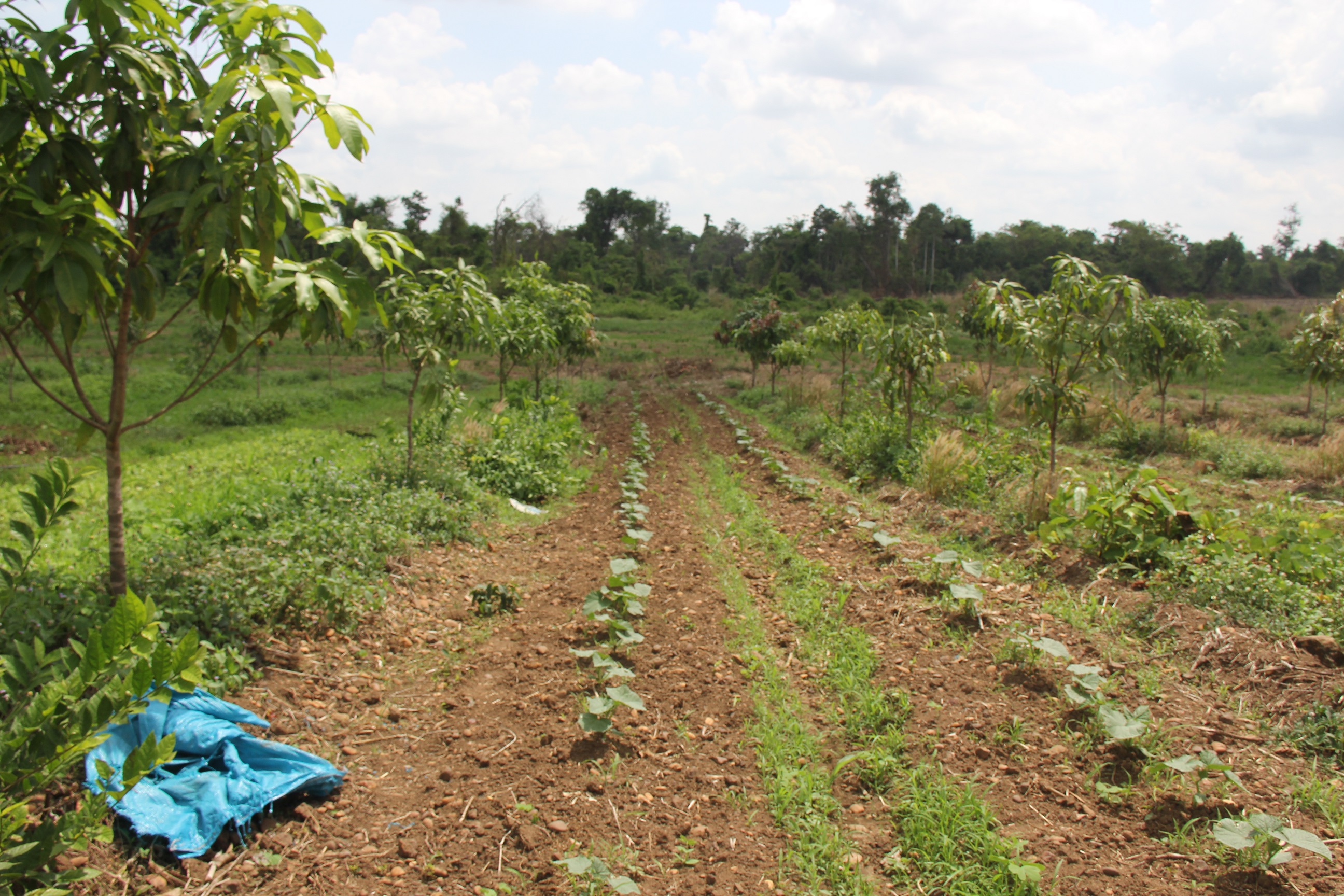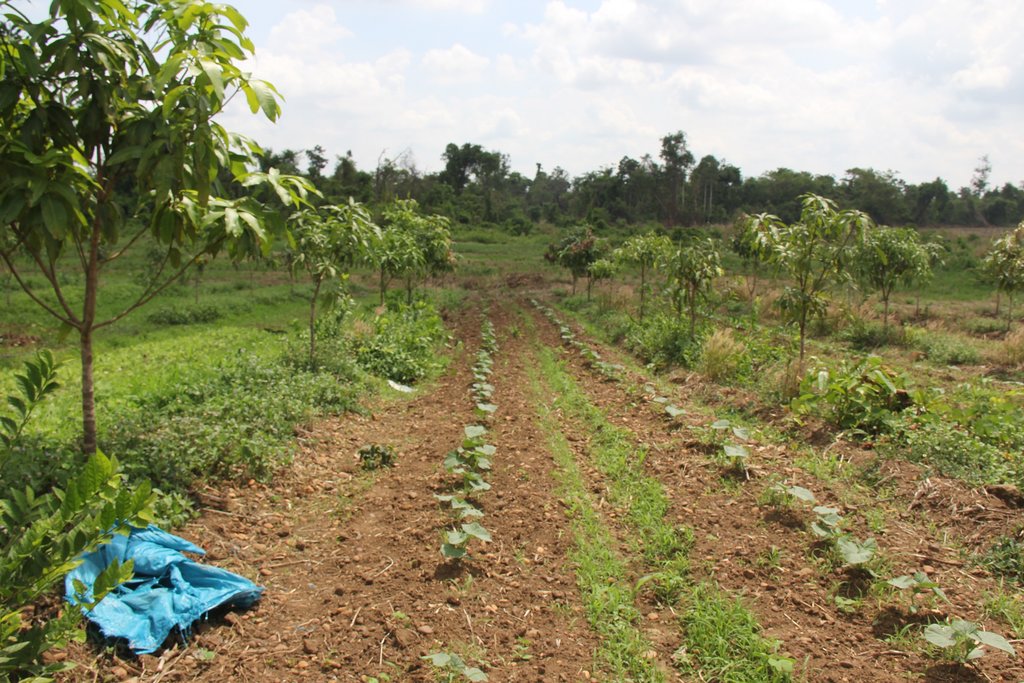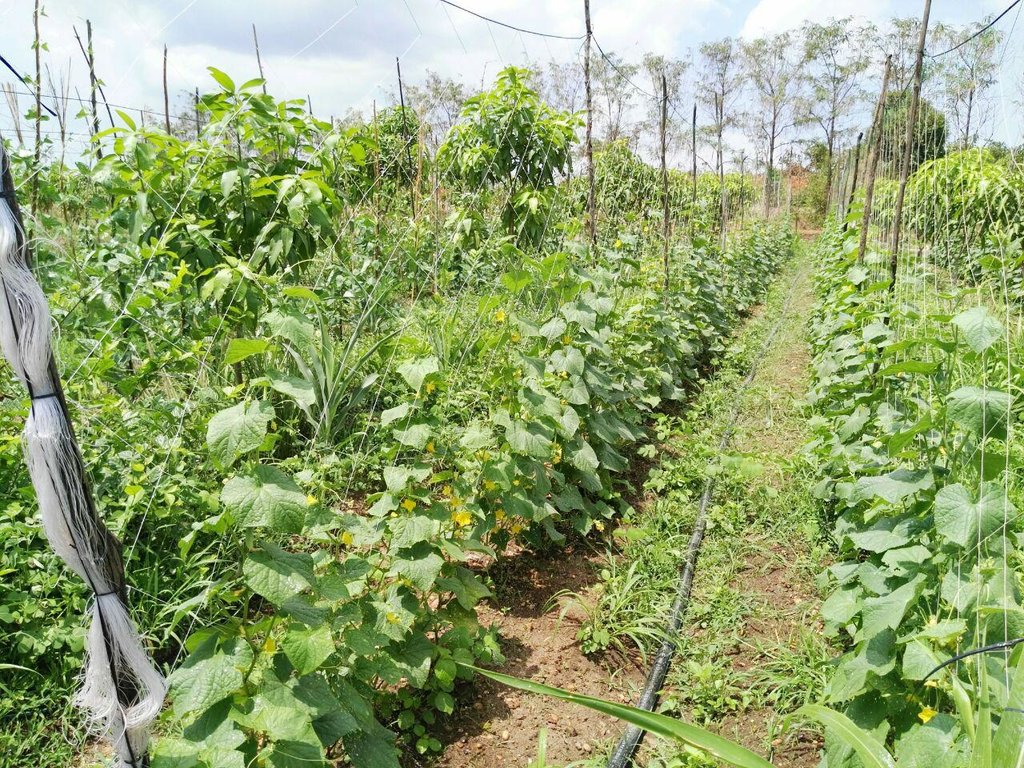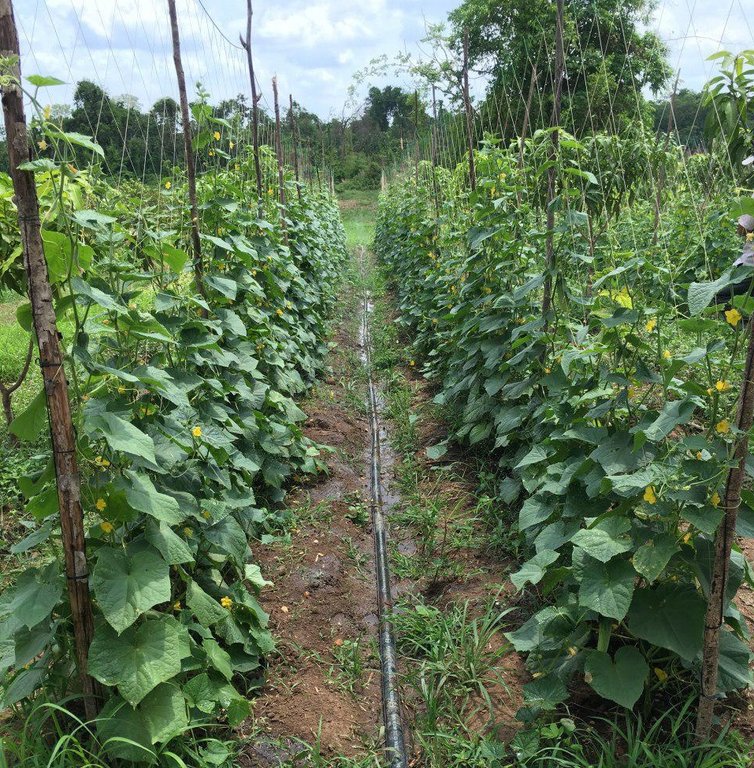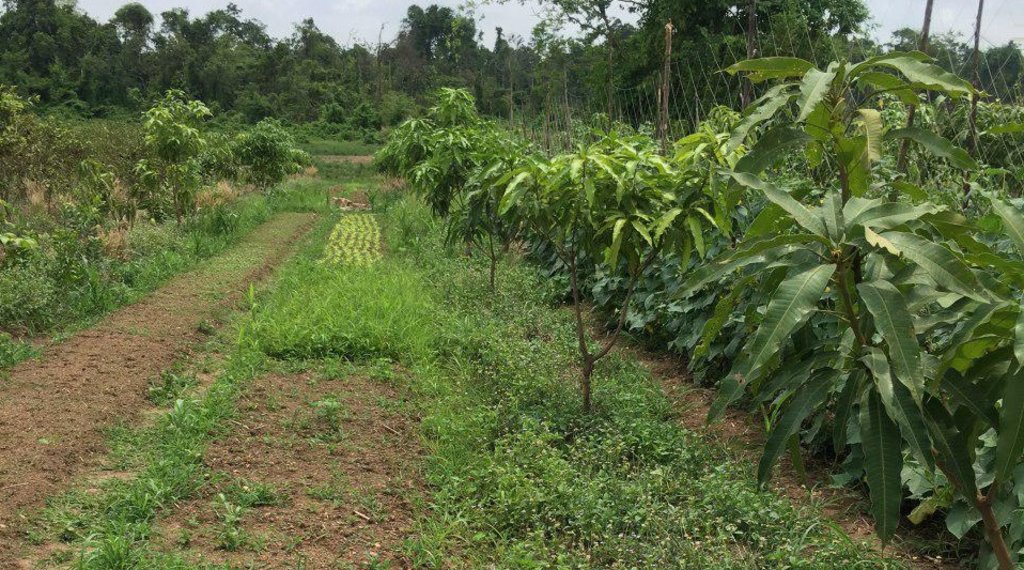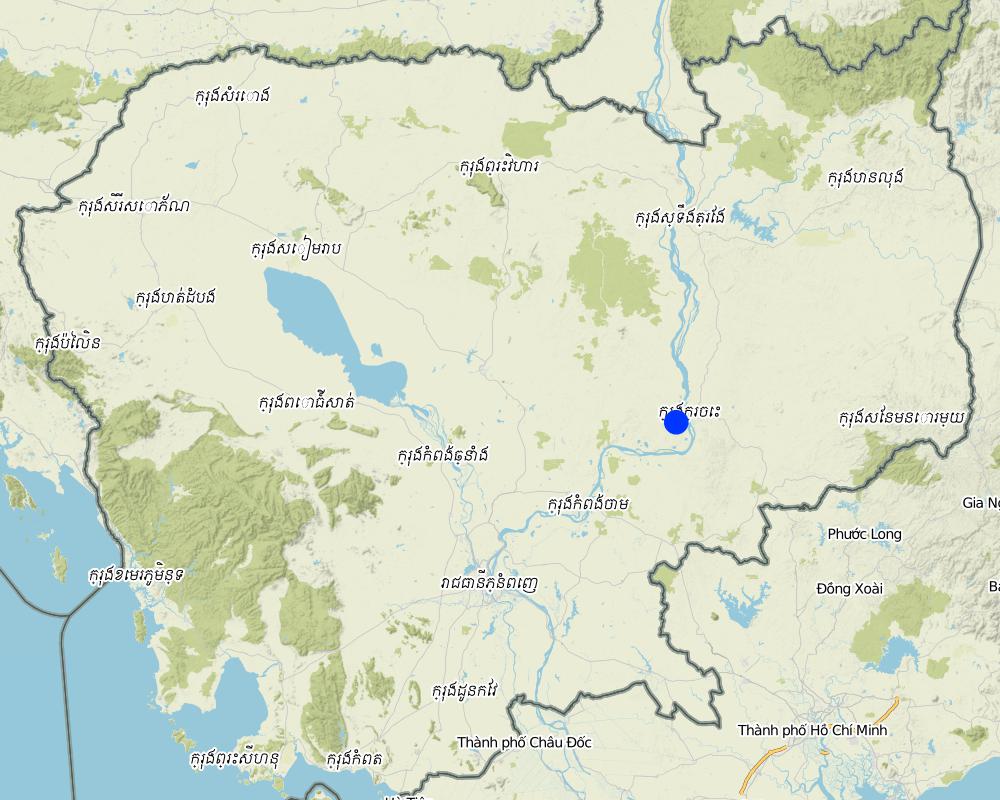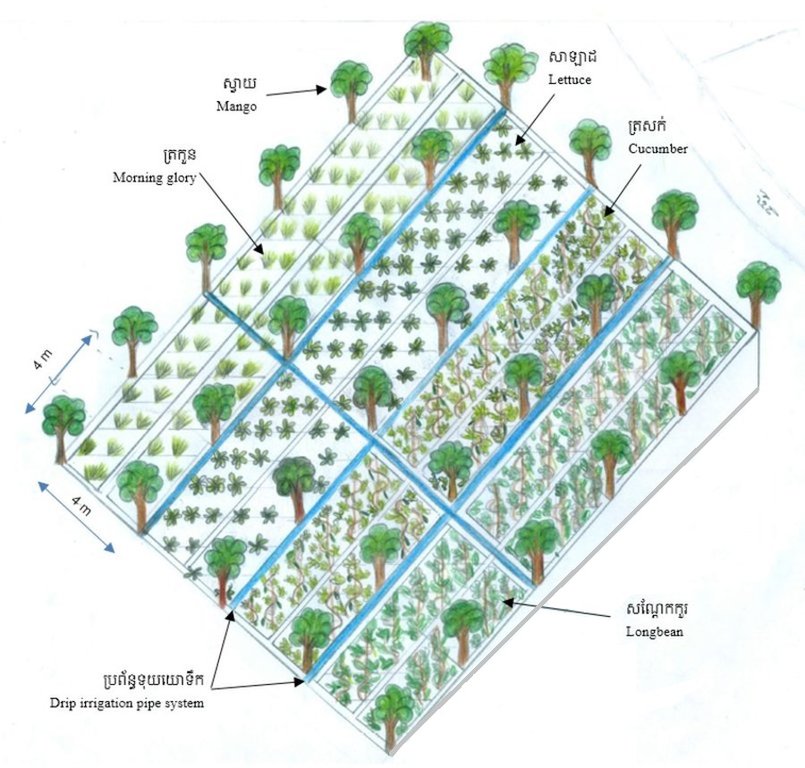ការដាំដំណាំវិលជុំនៅចន្លោះរងស្វាយដោយប្រើប្រព័ន្ធតំណក់ទឹក [Cambodia]
- Creation:
- Update:
- Compiler: Be Gechkim
- Editors: Navin Chea, Sophea Tim
- Reviewers: TOM SAY, SO Than, Ursula Gaemperli, Alexandra Gavilano
បន្លែសរីរាង្គ
technologies_2236 - Cambodia
View sections
Expand all Collapse all1. معلومات عامة
1.2 Contact details of resource persons and institutions involved in the assessment and documentation of the Technology
Key resource person(s)
land user:
ប្រុស ហ៊ួ
កសិករ
Cambodia
ប្រធានទទួលបន្ទុករួមការិយាល័យកសិកម្ម រុក្ខាប្រមាញ់ និងនេសាទ ស្រុកព្រែកប្រសព្វ:
ភ្នាក់ងារផ្សព្វផ្សាយឃុំនៅសាលាឃុំសោប:
សុភ័ក្រ សុង
ឃុំសោប ស្រុកព្រែកប្រសព្វ ខេត្តក្រចេះ
Cambodia
ប្រធានការិយាល័យកសិកម្ម រុក្ខាប្រមាញ់ និងនេសាទ ស្រុកសំបូរ:
មន្ត្រីការិយាល័យកសិកម្ម រុក្ខាប្រមាញ់ និងនេសាទ ស្រុកចិត្របុរី:
សារ៉ាវុធ លី
មន្ត្រីការិយាល័យកសិកម្ម រុក្ខាប្រមាញ់ និងនេសាទ ស្រុកចិត្របុរី
Cambodia
Name of project which facilitated the documentation/ evaluation of the Technology (if relevant)
Scaling-up SLM practices by smallholder farmers (IFAD)Name of the institution(s) which facilitated the documentation/ evaluation of the Technology (if relevant)
Royal University of Agriculture (RUA) - Cambodia1.3 Conditions regarding the use of data documented through WOCAT
The compiler and key resource person(s) accept the conditions regarding the use of data documented through WOCAT:
نعم
1.4 Declaration on sustainability of the described Technology
Is the Technology described here problematic with regard to land degradation, so that it cannot be declared a sustainable land management technology?
لا
2. Description of the SLM Technology
2.1 Short description of the Technology
Definition of the Technology:
ការដាំបន្លែជាលក្ខណៈវិលជុំ នៅតាមចន្លោះជួរស្វាយ គឺជាទម្រង់មួយនៃកសិរុក្ខកម្ម។ ការអនុវត្តនេះ គឺដើម្បីបង្កើនទិន្នផល និងប្រាក់ចំណូលសម្រាប់គ្រួសារ ក្នុងអំឡុងពេលដែលស្វាយនៅតូចមិនទាន់ផ្តល់ផល។ គោលបំណងផ្សេងទៀតនៃបច្ចេកទេស គឺការបង្កើតគម្របដីជាអចិន្ត្រៃយ៍មិនឱ្យស្មៅចង្រៃលូតលាស់ បន្ថយការបាត់បង់សំណើមដី និងទប់ស្កាត់ការហូរច្រោះ ហើយគោលបំណងចុងក្រោយ គឺការរួមផ្សំជាមួយប្រព័ន្ធតំណក់ទឹកដែលជួយបន្ស៊ាំទៅនឹងការប្រែប្រួលអាកាសធាតុ។
2.2 Detailed description of the Technology
Description:
កសិរុក្ខកម្ម គឺជាការអនុវត្តដាំដំណាំ និង/ឬចិញ្ចឹមសត្វនៅលើផ្ទៃដីតែមួយដោយដាំដុះលាយជាមួយនឹងដើមឈើ ដូចជាឈើហូបផ្លែ ដូង ឫស្សី និងដើមឈើផ្សេងទៀត ដើម្បីបង្កើនផលិតភាពកសិកម្ម និងទទួលបានអត្ថប្រយោជន៍ផ្សេងៗទៀត (MoE et al., 2016)។ កសិរុក្ខកម្មដើរតួនាទីយ៉ាងសំខាន់ក្នុងការផ្តល់ផលប្រយោជន៍ដល់ប្រព័ន្ធអេកូឡូស៊ី និងសេដ្ឋកិច្ច ដូចជា ការប្រមូលផលឈើ និងដំណាំរួមផ្សំ ធ្វើឲ្យដីកាន់តែមានជីជាតិ កាត់បន្ថយការប្រើប្រាស់ជី និងថ្នាំគីមីដែលនាំឲ្យថ្លៃដើមផលិតថយចុះ បន្ស៊ាំបានកាន់តែប្រសើរទៅនឹងការប្រែប្រួលអាកាសធាតុ (MoE et al., 2016) ក៏ដូចជាការជួយកាត់បន្ថយហានិភ័យនៃការខូចខាតផលដំណាំផងដែរ (FA and DANIDA, 2005)។
លោក ហួរ គឺជាកសិករមួយរូបក្នុងចំណោមកសិករច្រើននាក់ដែលបានផ្លាស់ប្តូរពីកសិកម្មឯកវប្បកម្មមកអនុវត្តប្រព័ន្ធកសិរុក្ខកម្ម។ រូបគាត់ និងក្រុមគ្រួសារ រស់នៅភូមិសោបក្រោម ឃុំ សោប ស្រុក ព្រែកប្រសព្វ ខេត្តក្រចេះ ដែលជាខេត្តមួយស្ថិតនៅប៉ែកឦសាននៃប្រទេសកម្ពុជា។ លើផ្ទៃដីដាំដុះទំហំ ២១០០ម៉ែត្រការ៉េ នៅតំបន់ជម្រាលភ្នំ គាត់មានស្វាយសរុបចំនួន ១៣៥ដើម ដោយដាំជា ៩ជួរ ហើយចន្លោះជួរ និងចន្លោះដើមមានប្រវែង ៤ម៉ែត្រដូចគ្នា។ តាមចន្លោះជួរស្វាយមានដាំបន្លែឆ្លាស់គ្នាជាច្រើនប្រភេទ ដូចជាសណ្តែកកួរ ត្រសក់ ត្រកួន ស្ពៃ និងសាលាដ ។ ស្វាយត្រូវបានដាំបន្ទាប់ពីភ្ជួរដីហាលរយៈ ១៥ថ្ងៃ ដោយជីករណ្តៅទំហំ ០,៥ម៉ែត្របួនជ្រុង ជាមួយជម្រៅ ០,៥ម៉ែត្រ និងបំពេញដោយលាមកគោ អង្កាម និងកន្ទក់ដែលបានផ្អាប់ទុក ១៥ថ្ងៃ ក្នុងមួយរណ្តៅប្រមាណជា ២ ទៅ ៣ គ.ក្រ។ កសិករបានប្រើប្រព័ន្ធស្រោចស្រពជាតំណក់ទឹក ដោយរាយទុយោដល់គល់ស្វាយ និងតាមបណ្តោយរងបន្លែទាំងអស់។ ការរៀបចំរងបន្លែ គឺប្រែប្រួលតាមរដូវកាល នៅរដូវប្រាំងគេលើករងកម្ពស់ ១០សង់ទីម៉ែត្រ ហើយនៅរដូវវស្សាគេលើករងកម្ពស់ ២០សង់ទីម៉ែត្រ ដើម្បីកុំឱ្យជាំទឹក។ ជាងនេះទៅទៀតការធ្វើកសិកម្មបែបនេះមិនមានការចំណាយច្រើន ហើយថែមទាំងជួយបង្កើនប្រាក់ចំណូលនៅពេលដំណាំអាយុកាលវែងមិនទាន់បានទទួលផល។ លើសពីនេះកសិករបានប្រើជីកំប៉ុស្តិ៍ទឹក និងថ្នាំសំលាប់សត្វល្អិតផ្សំពីធម្មជាតិ ដែលគាត់បានផលិតដោយខ្លួនឯង ធ្វើឲ្យគ្មានផលប៉ះពាល់អវិជ្ជមានដល់បរិស្ថានផងទៀតផង។ ការធ្វើជីកំប៉ុស្តិ៍ទឹក គឺគាត់ប្រើកម្ទេចកម្ទីត្រី កន្ទក់ និងស្ករក្រហម លាយជាមួយទឹក រួចរក្សាទុករយៈពេល ១៥ថ្ងៃ ទើបយកមកលាយទឹកបាញ់លើបន្លែ។ ចំណែកឯថ្នាំកំចាត់សត្វល្អិតត្រូវបានផ្សំពីសមាសធាតុរុក្ខជាតិផ្សេងៗដែលមានក្លិនក្រពុលខ្លាំង និងរសល្វីង ដូចជា សំបកស្លែង ក្តុល ស្តៅ វល្លិ៍បណ្តូលពេជ្រ និងរំដេង ដោយចិញ្ច្រាំវាឱ្យម៉ត់ ហើយលាយជាមួយស្ករក្រហម និងទឹក រួចបន្ទាប់មកត្រាំវាទុករយៈពេល ១៥ថ្ងៃ។ សម្រាប់ការប្រើប្រាស់ គឺត្រូវលាយទឹកថ្នាំចំណុះ ១លីត្រ ជាមួយទឹក ២៥លីត្រ។
សរុបមកបច្ចេកទេសកសិរុក្ខកម្មនេះបានផ្តល់នូវអត្ថប្រយោជន៍ច្រើនយ៉ាង។ ការដាំដំណាំបែបនេះអាចបង្កើនសេដ្ឋកិច្ចដោយការប្រមូលផលដំណាំផ្សេងៗគ្នា ទាំងក្នុងរដូវប្រាំង និងរដូវវស្សា ជាពិសេសក្នុងរយៈពេល ៣ឆ្នាំ ដំបូងដែលស្វាយមិនទាន់បានផ្តល់ផល ដូច្នេះ គឺទប់ទល់បាននឹងការចំណាយផ្សេងៗក្នុងកសិដ្ឋាន។ ការអនុវត្តបច្ចេកទេសនេះក៏ផ្តល់នូវភាពត្រជាក់ដល់ដីតាមរយៈម្លប់នៃដើមស្វាយ កាត់បន្ថយការបាត់បង់សំណើមដី ទប់ស្កាត់ការហូរច្រោះ ព្រមទាំងជួយបន្ស៊ាំទៅនឹងភាពហួតហែងដែលបណ្តាលមកពីការប្រែប្រួលអាកាសធាតុទៀតផង។ លើសពីនេះ ការអនុវត្តបែបនេះ គឺមិនទុកឱ្យដីនៅទំនេរចោលនាំឱ្យដុះស្មៅចង្រៃដែលជាជម្រកនៃការកកើតសត្វល្អិត និងជំងឺផ្សេងៗ ជាមូលហេតុនាំឱ្យបាត់បង់អត្ថប្រយោជន៍ផ្នែកសេដ្ឋកិច្ច។
បើមើលមួយភ្លែត វាអាចជាគុណវិបត្តិមួយដែរ ដែលកសិករត្រូវចំណាយច្រើនក្នុងគ្រាដំបូង ឧទាហរណ៍ដូចជាការតម្លើងប្រព័ន្ធតំណក់ទឹកជាដើម ប៉ុន្តែគេអាចប្រើបានក្នុងរយៈពេលច្រើនឆ្នាំ និងបន្ថយការចំណាយលើកម្លាំងពលកម្មស្រោចស្រព។ ចំពោះដំណាំបន្លែ កសិករមានភាពប្រឈមជាមួយនឹងតម្លៃបន្លែលើទីផ្សារមិនទៀងទាត់ ប្រសិនបើតម្លៃទីផ្សារមានស្ថេរភាព នោះកសិករនឹងទទួលបានចំណូលកាន់តែច្រើនសម្រាប់ការលើកកម្ពស់ជីវភាពគ្រួសារ។ ដូចនេះស្ថាប័នពាក់ព័ន្ធគួរយកចិត្តទុកដាក់លើបញ្ហាទីផ្សារនេះផងដែរ។
2.3 Photos of the Technology
2.4 Videos of the Technology
Comments, short description:
មិនមាន
Name of videographer:
មិនមាន
2.5 Country/ region/ locations where the Technology has been applied and which are covered by this assessment
بلد:
Cambodia
Region/ State/ Province:
ភូមិសោបក្រោម ឃុំសោប ស្រុកព្រែកប្រសព្វ ខេត្តក្រចេះ
Specify the spread of the Technology:
- evenly spread over an area
If precise area is not known, indicate approximate area covered:
- < 0.1 km2 (10 ha)
Map
×2.6 Date of implementation
Indicate year of implementation:
2015
2.7 Introduction of the Technology
Specify how the Technology was introduced:
- through projects/ external interventions
Comments (type of project, etc.):
ជំនួយបច្ចេកទេសពីកម្មវិធីផ្សព្វផ្សាយបច្ចេកទេសកសិកម្មថ្មីដែលធន់ទៅនឹងការប្រែប្រួលអាកាសធាតុ (ASPIRE)
3. Classification of the SLM Technology
3.1 Main purpose(s) of the Technology
- improve production
- create beneficial economic impact
3.2 Current land use type(s) where the Technology is applied
Land use mixed within the same land unit:
نعم
Specify mixed land use (crops/ grazing/ trees):
- Agroforestry

الأراضي الزراعية
- Annual cropping
- Tree and shrub cropping
Annual cropping - Specify crops:
- fodder crops - grasses
- vegetables - leafy vegetables (salads, cabbage, spinach, other)
- legumes and pulses - other
- legumes and pulses - beans
- ត្រសក់។
Annual cropping system:
Vegetables - wheat/barley/oat/upland rice
Tree and shrub cropping - Specify crops:
- mango, mangosteen, guava
Number of growing seasons per year:
- 1
حددها:
ជាប្រភេទដំណាំរយៈពេលវែង និងមានដំណាំផ្សេងៗចន្លោះមុនពេលទទួលផលស្វាយ
3.3 Has land use changed due to the implementation of the Technology?
Has land use changed due to the implementation of the Technology?
- Yes (Please fill out the questions below with regard to the land use before implementation of the Technology)

Forest/ woodlands
Comments:
ជាប្រភេទដីព្រៃមិនសូវសម្បូរជីជាតិ
3.4 Water supply
Water supply for the land on which the Technology is applied:
- mixed rainfed-irrigated
Comments:
ប្រើប្រាស់ទឹកពីទំនប់ស្រែងៀត
3.5 SLM group to which the Technology belongs
- rotational systems (crop rotation, fallows, shifting cultivation)
- improved ground/ vegetation cover
- irrigation management (incl. water supply, drainage)
3.6 SLM measures comprising the Technology

agronomic measures
- A1: Vegetation/ soil cover

structural measures
- S7: Water harvesting/ supply/ irrigation equipment
3.7 Main types of land degradation addressed by the Technology

soil erosion by water
- Wt: loss of topsoil/ surface erosion

chemical soil deterioration
- Cn: fertility decline and reduced organic matter content (not caused by erosion)

biological degradation
- Bc: reduction of vegetation cover
3.8 Prevention, reduction, or restoration of land degradation
Specify the goal of the Technology with regard to land degradation:
- reduce land degradation
- restore/ rehabilitate severely degraded land
Comments:
គាត់អាចដាំដំណាំដែលជួយបង្ការការហូរច្រោះដោយសារទឹកភ្លៀងនៅក្នុងរដូវរស្សា ពីមុនដីនេះជាដីព្រៃសឹករេចរិល។
4. Technical specifications, implementation activities, inputs, and costs
4.1 Technical drawing of the Technology
Technical specifications (related to technical drawing):
បច្ចេកទេសនេះត្រូវបានអនុវត្តលើផ្ទៃដីដាំដុះទំហំ ២១០០ម៉ែត្រការ៉េ (ទទឹង ៣៥ ម៉ែត្រ x បណ្តោយ ៦០ ម៉ែត្រ) នៅតំបន់ជម្រាលភ្នំ។ ក្នុងទំហំផ្ទៃដីនេះមានដាំស្វាយសរុបចំនួន ១៣៥ដើម (ចំនួន ៩ជួរ ហើយចន្លោះជួរ និងចន្លោះដើមមានទំហំ ៤ម៉ែត្រ) និងមានដាំបន្លែដូចជាសណ្តែកកួរ ត្រសក់ ត្រកួន សាលាដ ស្ពៃ ឆ្លាស់គ្នានៅតាមចន្លោះជួរស្វាយ។ ប្រព័ន្ធស្រោចស្រពដោយតំណក់ត្រូវបានពង្រាយលើផ្ទៃដីទាំងមូល ដោយរាយទុយោតំណក់ទឹកដល់គ្រប់គល់ស្វាយ និងតាមរងដំណាំ។
Author:
កញ្ញា សូ គង្គា និង លោក ទឹម សុភា
Date:
12/04/2017
4.2 General information regarding the calculation of inputs and costs
Specify how costs and inputs were calculated:
- per Technology area
Indicate size and area unit:
២១០០ ម៉ែត្រការ៉េ
other/ national currency (specify):
រៀល
If relevant, indicate exchange rate from USD to local currency (e.g. 1 USD = 79.9 Brazilian Real): 1 USD =:
4000,0
Indicate average wage cost of hired labour per day:
២០០០០រៀល
4.3 Establishment activities
| Activity | Timing (season) | |
|---|---|---|
| 1. | ភ្ជួរដីហាល | ខែមេសា |
| 2. | បណ្តុះកូនស្វាយ | ខែមេសា |
| 3. | ជីករណ្តៅ និងរៀបប្រព័ន្ធទុយោ | ខែមេសា |
| 4. | ធ្វើថ្នាំសំលាប់សត្វល្អិត និងជីទឹក | ខែមេសា |
| 5. | ដាំកូនស្វាយ | ខែកញ្ញា |
| 6. | វាយដី និងលើករង | ខែមេសា |
4.4 Costs and inputs needed for establishment
| Specify input | Unit | Quantity | Costs per Unit | Total costs per input | % of costs borne by land users | |
|---|---|---|---|---|---|---|
| Labour | ភ្ជួរ និងរាស់ដី | នាក់/ថ្ងៃ | 3,0 | 20000,0 | 60000,0 | 100,0 |
| Labour | ជីករណ្តៅ | នាក់/ថ្ងៃ | 5,4 | 20000,0 | 108000,0 | 100,0 |
| Equipment | ប្រព័ន្ធដំណក់ទឹក | ឈុត | 1,0 | 800000,0 | 800000,0 | 100,0 |
| Equipment | ក្បាលចម្រោះ | គ្រឿង | 1,0 | 120000,0 | 120000,0 | 100,0 |
| Equipment | ចបជីក | ចប | 2,0 | 15000,0 | 30000,0 | 100,0 |
| Equipment | គោយន្ត | គ្រឿង | 1,0 | 4800000,0 | 4800000,0 | 100,0 |
| Plant material | ដើមស្វាយ | ដើម | 135,0 | 5000,0 | 675000,0 | 100,0 |
| Fertilizers and biocides | ជីត្រី | លីត្រ | 200,0 | 300,0 | 60000,0 | 100,0 |
| Construction material | សំណាញ់សម្រាប់ធ្វើទ្រើង | ដុំ | 18,0 | 15000,0 | 270000,0 | 100,0 |
| Construction material | ឫស្សីទ្រើង | សរុប | 1,0 | 100000,0 | 100000,0 | 100,0 |
| Total costs for establishment of the Technology | 7023000,0 | |||||
| Total costs for establishment of the Technology in USD | 1755,75 | |||||
Comments:
ទាក់ទងនឹងចំណាយ "ការជីករណ្តៅ" កសិករបានបញ្ជាក់ថាតម្លៃ ៨០០ រៀលសម្រាប់រន្ធមួយ (៨០០ X ១៣៥ រណ្តៅ = ១០៨០០០) ហើយនៅក្នុងតារាងចំណាយខាងលើត្រូវបានគណនាជានាក់/ថ្ងៃ។
4.5 Maintenance/ recurrent activities
| Activity | Timing/ frequency | |
|---|---|---|
| 1. | បណ្តុះកូនបន្លែ | ខែមេសា |
| 2. | ស្ទូងបន្លែ | ខែមេសា |
| 3. | ធ្វើទ្រើង (វល្លិ៍) | ខែមេសា |
| 4. | ធ្វើស្មៅ | ១០ថ្ងៃដំបូង |
| 5. | បាញ់ថ្នាំការពារ | ពេលមានសត្វល្អិត |
| 6. | ដូរទុយោ | ពេលធ្លុះធ្លាយ |
4.6 Costs and inputs needed for maintenance/ recurrent activities (per year)
| Specify input | Unit | Quantity | Costs per Unit | Total costs per input | % of costs borne by land users | |
|---|---|---|---|---|---|---|
| Labour | លើករង | នាក់/ថ្ងៃ | 3,0 | 20000,0 | 60000,0 | 100,0 |
| Labour | ស្ទូងបន្លែ ឬដាំ | នាក់/ថ្ងៃ | 2,0 | 20000,0 | 40000,0 | 100,0 |
| Labour | ធ្វើស្មៅ | នាក់/ថ្ងៃ | 9,0 | 20000,0 | 180000,0 | 100,0 |
| Labour | បាញ់ថ្នាំការពារ | នាក់/ថ្ងៃ | 1,0 | 20000,0 | 20000,0 | 100,0 |
| Equipment | ទុយោ | ដុំ | 3,0 | 100000,0 | 300000,0 | 100,0 |
| Plant material | ពូជត្រសក់ | កញ្ចប់ | 4,0 | 10000,0 | 40000,0 | 100,0 |
| Plant material | ពូជសណ្តែកកួរ | កញ្ចប់ | 1,0 | 3500,0 | 3500,0 | 100,0 |
| Fertilizers and biocides | ថ្នាំកំចាត់សត្វល្អិត | លីត្រ | 20,0 | 2000,0 | 40000,0 | 100,0 |
| Other | ដូរទុយោ | នាក់/ថ្ងៃ | 1,0 | 20000,0 | 20000,0 | 100,0 |
| Total costs for maintenance of the Technology | 703500,0 | |||||
| Total costs for maintenance of the Technology in USD | 175,88 | |||||
Comments:
ការថែទាំគិតត្រឹមរយៈពេល ៣ខែប៉ុណ្ណោះអាស្រ័យតាមវដ្តដំណាំដែលដាំក្រោមដើមស្វាយ។
4.7 Most important factors affecting the costs
Describe the most determinate factors affecting the costs:
ត្រូវចំណាយដើមទុនច្រើនទៅលើប្រព័ន្ធទុយោ។
5. Natural and human environment
5.1 Climate
Annual rainfall
- < 250 mm
- 251-500 mm
- 501-750 mm
- 751-1,000 mm
- 1,001-1,500 mm
- 1,501-2,000 mm
- 2,001-3,000 mm
- 3,001-4,000 mm
- > 4,000 mm
Specify average annual rainfall (if known), in mm:
1138,20
Specifications/ comments on rainfall:
បរិមាណទឹកភ្លៀងនៅឆ្នាំ ២០១៥ គឺ ១១៣៨,២ មម ឆ្នាំ ២០១៤ គឺ ១៦៩៦,៥ មម និងឆ្នាំ២០១៣ គឺ ១៦៦១,៨ មម។
Indicate the name of the reference meteorological station considered:
ក្រសួងធនធានទឹក និងឧតុនិយម នាយកដ្ឋានឧតុនិយមឆ្នាំ2015
Agro-climatic zone
- sub-humid
អាសធាតុក្តៅហើយសើម មាន 2រដូវ គឺរដូវប្រាំង និងវស្សា។
5.2 Topography
Slopes on average:
- flat (0-2%)
- gentle (3-5%)
- moderate (6-10%)
- rolling (11-15%)
- hilly (16-30%)
- steep (31-60%)
- very steep (>60%)
Landforms:
- plateau/plains
- ridges
- mountain slopes
- hill slopes
- footslopes
- valley floors
Altitudinal zone:
- 0-100 m a.s.l.
- 101-500 m a.s.l.
- 501-1,000 m a.s.l.
- 1,001-1,500 m a.s.l.
- 1,501-2,000 m a.s.l.
- 2,001-2,500 m a.s.l.
- 2,501-3,000 m a.s.l.
- 3,001-4,000 m a.s.l.
- > 4,000 m a.s.l.
Indicate if the Technology is specifically applied in:
- not relevant
5.3 Soils
Soil depth on average:
- very shallow (0-20 cm)
- shallow (21-50 cm)
- moderately deep (51-80 cm)
- deep (81-120 cm)
- very deep (> 120 cm)
Soil texture (topsoil):
- coarse/ light (sandy)
Soil texture (> 20 cm below surface):
- medium (loamy, silty)
Topsoil organic matter:
- high (>3%)
If available, attach full soil description or specify the available information, e.g. soil type, soil PH/ acidity, Cation Exchange Capacity, nitrogen, salinity etc.
ដីគ្រួស និងថ្ម
5.4 Water availability and quality
Ground water table:
5-50 m
Availability of surface water:
good
Water quality (untreated):
for agricultural use only (irrigation)
Is water salinity a problem?
لا
Is flooding of the area occurring?
لا
Comments and further specifications on water quality and quantity:
អាចទទួលបានតែទឹកសម្រាប់កសិកម្មប៉ុណ្ណោះ ដែលទាញពីទំនប់ស្រែងៀត។
5.5 Biodiversity
Species diversity:
- low
Habitat diversity:
- low
5.6 Characteristics of land users applying the Technology
Sedentary or nomadic:
- Sedentary
Market orientation of production system:
- commercial/ market
Off-farm income:
- 10-50% of all income
Relative level of wealth:
- average
Individuals or groups:
- individual/ household
Level of mechanization:
- manual work
- mechanized/ motorized
Gender:
- men
Age of land users:
- middle-aged
5.7 Average area of land used by land users applying the Technology
- < 0.5 ha
- 0.5-1 ha
- 1-2 ha
- 2-5 ha
- 5-15 ha
- 15-50 ha
- 50-100 ha
- 100-500 ha
- 500-1,000 ha
- 1,000-10,000 ha
- > 10,000 ha
Is this considered small-, medium- or large-scale (referring to local context)?
- medium-scale
Comments:
ខ្នាតមធ្យមដោយសារគាត់មានដីទំហំ ៣០ហិកតា និងមានអ្នកមានដីច្រើនហិកតារហូតដល់ ៥០ហិកតា។
5.8 Land ownership, land use rights, and water use rights
Land ownership:
- individual, titled
- ដីរានព្រៃ
Land use rights:
- individual
Water use rights:
- individual
5.9 Access to services and infrastructure
health:
- poor
- moderate
- good
education:
- poor
- moderate
- good
technical assistance:
- poor
- moderate
- good
employment (e.g. off-farm):
- poor
- moderate
- good
markets:
- poor
- moderate
- good
energy:
- poor
- moderate
- good
roads and transport:
- poor
- moderate
- good
drinking water and sanitation:
- poor
- moderate
- good
financial services:
- poor
- moderate
- good
6. Impacts and concluding statements
6.1 On-site impacts the Technology has shown
Socio-economic impacts
Production
crop production
Comments/ specify:
ជាក់ស្តែងកសិករដាំដំណាំច្រើនប្រភេទជាងពីមុននៅលើផ្ទៃដីដដែល ដូចនេះគាត់អាចប្រមូលផលបន្តបន្ទាប់ពីដំណាំទាំងនោះ ដូចជាដំណាំអាយុកាលវែង និងដំណាំប្រចាំឆ្នាំ។
risk of production failure
Comments/ specify:
តាមរយៈការដាំដំណាំរយៈពេលវែង និងដំណាំរយៈពេលខ្លីជាមួយគ្នា បានជួយកាត់បន្ថយហានិភ័យនៃភាពបរាជ័យបាន។
product diversity
Comments/ specify:
ដោយសារមានដាំដំណាំជាប្រព័ន្ធចម្រុះដែលមានដំណាំច្រើនប្រភេទចម្រុះគ្នា។
production area
Comments/ specify:
ដីកាលដើមឡើយជាប្រភេទដីព្រៃសឹករេចរិល ប៉ុន្តែឥលូវគាត់អាចដាំដំណាំបានតាមបច្ចេកទេស SLM នេះ។
land management
Comments/ specify:
គាត់ដាំដំណាំច្រើនប្រភេទ ហើយប្រើប្រាស់តែជីធម្មជាតិ និងថ្នាំពុលការពារដំណាំផ្សំពីរុក្ខជាតិដែលបានផលិតដោយគាត់ផ្ទាល់។
Income and costs
expenses on agricultural inputs
Comments/ specify:
បច្ចុប្បន្ននេះគាត់មិនចាំបាច់ទិញជីថ្នាំគីមីទៀតទេ ហើយគាត់ព្យាយាមប្រើប្រាស់ថ្នាំសំលាប់សត្វល្អិតដែលផលិតដោយខ្លួនឯង។
farm income
Comments/ specify:
គាត់អាចទទួលបានចំណូលពេញមួយឆ្នាំពីព្រោះគាត់បានដាំទាំងដំណាំអាយុកាលវែង និងខ្លី។
diversity of income sources
Comments/ specify:
តាមរយៈការដាំដំណាំច្រើនជាងមួយប្រភេទលើផ្ទៃដីដដែលបណ្តាលឱ្យគាត់ទទួលបានប្រភពចំណូលកើនឡើងប៉ុន្តែតិចតួចប៉ុណ្ណោះ។
workload
Comments/ specify:
គម្របដីល្អដែលបានពីការដាំដំណាំឆ្លាស់បានជួយបញ្ជៀសការដុះលូតលាស់នៃស្មៅចង្រៃ និងជួយកាត់បន្ថយកម្លាំងពលកម្មក្នុងធ្វើស្មៅផងដែរ។
Socio-cultural impacts
food security/ self-sufficiency
Comments/ specify:
គាត់ដាំដំណាំច្រើនជាងមុនធ្វើឱ្យសន្តិសុខស្បៀងកាន់តែប្រសើរ។
health situation
Comments/ specify:
ការបំពុលបរិស្ថានត្រូវបានកាត់បន្ថយដោយសារគាត់ប្រើប្រាស់តែជីធម្មជាតិ និងថ្នាំពុលការពារដំណាំផ្សំពីរុក្ខជាតិប៉ុណ្ណោះ។ ដូចនេះស្ថានភាពសុខភាពកាន់តែប្រើសើរឡើង។
SLM/ land degradation knowledge
Comments/ specify:
ចំណេះដឹងដែលពាក់ព័ន្ធនឹងដី គឺគាត់ទទួលបានពីបទពិសោធន៍របស់គាត់ និងតាមរយៈឯកសារ ឬវីដេអូលើប្រព័ន្ធអ៊ីនធឺណេត។
Ecological impacts
Soil
soil moisture
Comments/ specify:
មានដំណាំគម្របដីកាន់តែច្រើន គឺបានជួយកាត់បន្ថយរំហួតតាមនោះដែរ។
soil cover
Comments/ specify:
តាមរយៈការដាំបន្លែឆ្លាស់គ្នាបានធ្វើឱ្យគម្របដីល្អប្រសើរ
soil compaction
Comments/ specify:
ឫសរបស់ដំណាំស្វាយបានចាក់ចូលទៅក្នុងដីធ្វើឱ្យដីផុសល្អ
Biodiversity: vegetation, animals
Vegetation cover
Comments/ specify:
ដោយសារតែមានដំណាំគម្របដីជាអចិន្ត្រៃយ៍ពេញមួយឆ្នាំ
invasive alien species
Comments/ specify:
ប្រភេទរាតត្បាត គឺត្រូវបានកាត់បន្ថយតាមរយៈការដាំដំណាំវិលជុំ និងការប្រើប្រាស់ថ្នាំពុលការពារដំណាំផ្សំពីរុក្ខជាតិ។
beneficial species
Comments/ specify:
ប្រភេទសត្វមានប្រយោជន៍កើនឡើងពីព្រោះតែការប្រើប្រាស់ជីកំប៉ុស្តិ៍ទឹក។
pest/ disease control
Comments/ specify:
ថ្នាំសម្លាប់សត្វល្អិតផ្សំពីធម្មជាតិដែលគាត់ផលិតដោយខ្លួនគាត់ គឺមានប្រសិទ្ធភាពខ្ពស់។
6.2 Off-site impacts the Technology has shown
Specify assessment of off-site impacts (measurements):
មិនមានផលប៉ះពាល់ខាងក្រៅបរិវេណគួរឱ្យកត់សម្គាល់ទេ
6.3 Exposure and sensitivity of the Technology to gradual climate change and climate-related extremes/ disasters (as perceived by land users)
Gradual climate change
Gradual climate change
| Season | increase or decrease | How does the Technology cope with it? | |
|---|---|---|---|
| annual temperature | increase | well | |
| seasonal temperature | wet/ rainy season | increase | well |
| seasonal temperature | dry season | increase | well |
| annual rainfall | decrease | moderately | |
| seasonal rainfall | wet/ rainy season | increase | well |
| other gradual climate change | ភ្លៀងធ្លាក់មានការប្រែម្រួល មានការរាំងរហូតដល់ខែ០៧ ទើបភ្លៀង |
Climate-related extremes (disasters)
Meteorological disasters
| How does the Technology cope with it? | |
|---|---|
| local rainstorm | moderately |
Climatological disasters
| How does the Technology cope with it? | |
|---|---|
| heatwave | not well |
| cold wave | well |
| extreme winter conditions | moderately |
Biological disasters
| How does the Technology cope with it? | |
|---|---|
| epidemic diseases | well |
| insect/ worm infestation | well |
Other climate-related consequences
Other climate-related consequences
| How does the Technology cope with it? | |
|---|---|
| មិនមានបញ្ហាដោយសារមានប្រភពទឹក និងប្រព័ន្ធស្រោចស្រព |
6.4 Cost-benefit analysis
How do the benefits compare with the establishment costs (from land users’ perspective)?
Short-term returns:
positive
Long-term returns:
positive
How do the benefits compare with the maintenance/ recurrent costs (from land users' perspective)?
Short-term returns:
positive
Long-term returns:
very positive
6.5 Adoption of the Technology
- single cases/ experimental
Of all those who have adopted the Technology, how many did so spontaneously, i.e. without receiving any material incentives/ payments?
- 91-100%
Comments:
ដោយសារមិនមានតម្រូវការថែទាំច្រើន និងចេញកម្លាំងពលកម្មច្រើន។
6.6 التكيف
Has the Technology been modified recently to adapt to changing conditions?
لا
6.7 Strengths/ advantages/ opportunities of the Technology
| Strengths/ advantages/ opportunities in the land user’s view |
|---|
| មិនចំណាយកម្លាំងពលកម្មច្រើន/កាត់បន្ថយបន្ទុកការងារតាមរយៈការប្រើប្រព័ន្ធតំណក់ទឹក |
| មានបន្លែច្រើនមុខអាចតម្រូវទៅតាមទីផ្សារ |
| កុំឱ្យដីទំនេរចោល និងមានស្មៅដុះច្រើន |
| Strengths/ advantages/ opportunities in the compiler’s or other key resource person’s view |
|---|
| កាត់បន្ថយកម្លាំងពលកម្ម ដោយមានរៀបចំប្រព័ន្ធទុយោសម្រាប់ការស្រោចស្រព និងដាក់ជី |
| មិនប៉ះពាល់បរិស្ថាន ដោយមិនត្រូវការម៉ាស៊ីន/ឥន្ធនៈផ្សេងៗសម្រាប់ស្រោចស្រពដោយប្រើប្រព័ន្ធបូមទឹកស្វ័យប្រវត្តិដែលដំណើរការដោយកម្លាំងទឹកហូរ។ |
| ការគ្រប់គ្រងដីបានល្អប្រសើរ ដោយអន្តរកម្មរវាងដំណាំ និងដើមឈើ |
| ការដាំដំណាំវិលជុំជួយរក្សាស្ថេរភាពជីជាតិដី និងបង្កើនគម្របដី |
6.8 Weaknesses/ disadvantages/ risks of the Technology and ways of overcoming them
| Weaknesses/ disadvantages/ risks in the land user’s view | How can they be overcome? |
|---|---|
| ខ្វះខាតដើមទុនមួយចំនួន | កម្ចីពីស្ថាប័នមីក្រូហិរញ្ញវត្ថុ ឬរដ្ឋក្នុងអត្រាការប្រាក់ទាប ឬរដ្ឋ ជួយគាំទ្របន្ថែម។ |
| ទីផ្សារមិនមានស្ថេរភាព | ចងក្រងជាក្រុមកសិករ និងស្វែងរកការគាំទ្រពីអង្គការ និងមន្ទីរដើម្បីជួយរកបណ្តាញទីផ្សារ។ |
| ចំណាយទុនច្រើនពេលចាប់ផ្តើមដំបូងសម្រាប់ការរៀបចំប្រព័ន្ធស្រោចស្រពដោយតំណក់ទឹក។ | គួរមានការគាំទ្រជាបដិភាគពីគម្រោង និងរដ្ឋ |
| Weaknesses/ disadvantages/ risks in the compiler’s or other key resource person’s view | How can they be overcome? |
|---|---|
| នៅពេលស្វាយធំបែកមែកសាខាបាំងពន្លឺវានឹងមិនអាចដាំដំណាំបានទៀតទេ។ | ដាំដំណាំផ្សេងៗដែលមិនសូវត្រូវការពន្លឺ និងធន់ពេលនៅក្រោមម្លប់។ |
7. References and links
7.1 Methods/ sources of information
- field visits, field surveys
១ កន្លែង
- interviews with land users
១ នាក់
- interviews with SLM specialists/ experts
៤ នាក់
When were the data compiled (in the field)?
12/04/2017
7.2 References to available publications
Title, author, year, ISBN:
Yang S. and Pean S. (2012) Organic fertilizer: Technology principle and farmer experiences. Cambodian Center for Study and Development in Agriculture: Phnom Penh. (In Khmer)
Available from where? Costs?
CEDAC and price is about 10000 Riel
Title, author, year, ISBN:
FA and DANIDA (2005). Guidelines for Site Selection and Tree Planting in Cambodia. Forestry Administration. Retrieved on May 15 2017 from
Available from where? Costs?
http://treeseedfa.org/guidelines_site_eng.htm
Title, author, year, ISBN:
MoE, Adaptation Fund and UNEP (2016). Agroforestry System: “Enhancing Climate Change Resilience of Rural Communities Living in Protected Areas in Cambodia”. Ministry of Environment.
Links and modules
Expand all Collapse allLinks
No links
Modules
No modules


